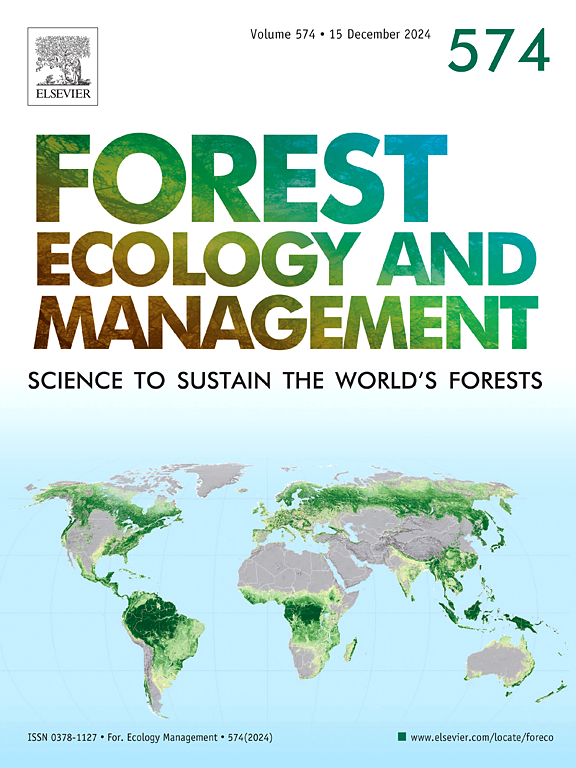增加光照强度无法抵消去除子叶对柞树幼苗存活、生长和蓄积的负面影响
IF 3.7
2区 农林科学
Q1 FORESTRY
引用次数: 0
摘要
羽化后的子叶捕食会阻碍橡树幼苗的建立,从而影响森林的更新。森林微生境的环境变化,特别是光照强度的变化,也会影响幼苗的形成。然而,对去除子叶和光照强度对橡树幼苗子叶矿物质储存和再动员的交互作用研究较少。在模拟落叶和常绿林下条件的条件下,研究了不同光照强度(中、低)下去除子叶时间对栓皮栎子叶资源再调动及幼苗存活、生长和贮藏的影响。在羽化后的前8天,光照强度对子叶矿物质的再动员没有影响,但促进了子叶非结构性碳水化合物的减少。早期子叶切除(羽化后第4天)和光照强度降低降低了存活率。只有在出苗后8天内去除子叶,低光强才能降低幼苗质量和非结构性碳水化合物含量。这种交互负效应对出苗后4 d内的磷含量也有影响。除去子叶,而不是光强,降低了幼苗的氮含量。羽化12 d后去子叶的幼苗氮含量与未去子叶的幼苗相近。林下光照强度适中,可部分缓解早期子叶脱落对幼苗性能的负面影响。然而,在深荫下,早期子叶的去除会阻碍幼苗的整体表现,这表明在常绿林中,早期子叶的捕食可能比落叶林中更能减少幼苗的补充。本文章由计算机程序翻译,如有差异,请以英文原文为准。
Increased light intensity cannot offset negative legacy effects of cotyledon removal on survival, growth, and storage building in Quercus variabilis seedlings
Post-emergence cotyledon predation can hinder oak seedling establishment and consequently affect forest regeneration. Environmental variations among forest microsites, particularly in light intensity, can also influence seedling establishment. However, there is limited research on the interactive effects of cotyledon removal and light intensity on the storage and remobilization of cotyledon minerals in oak seedlings. We conducted an experiment to investigate the effect of cotyledon removal time and two levels of light intensity (moderate and low), mimicking understory conditions in deciduous and evergreen forests on cotyledon resource remobilization, as well as seedling survival, growth, and storage in Quercus variabilis seedlings. Light intensity did not affect cotyledon mineral remobilization but enhanced the reduction of cotyledon nonstructural carbohydrates during the first 8 days after emergence. Early cotyledon removal (up to day 4 after emergence) together with decreased light intensity reduced survival. Low light intensity reduced seedling mass and non-structural carbohydrate content only when cotyledons were removed within the first 8 days after emergence. This interactive negative effect also influenced seedling phosphorous content within the first 4 days after emergence. Cotyledon removal, not light intensity, decreased seedling nitrogen (N) content. Seedlings with cotyledons removed after day 12 of emergence showed N content similar to that of seedlings with intact cotyledons. Moderate light intensity in the forest understory can partially alleviate the negative legacy effects of early cotyledon removal on seedling performance. However, early cotyledon removal under deep shade hinders overall seedling performance, suggesting that early cotyledon predation can potentially reduce recruitment more in evergreen forests than deciduous ones.
求助全文
通过发布文献求助,成功后即可免费获取论文全文。
去求助
来源期刊

Forest Ecology and Management
农林科学-林学
CiteScore
7.50
自引率
10.80%
发文量
665
审稿时长
39 days
期刊介绍:
Forest Ecology and Management publishes scientific articles linking forest ecology with forest management, focusing on the application of biological, ecological and social knowledge to the management and conservation of plantations and natural forests. The scope of the journal includes all forest ecosystems of the world.
A peer-review process ensures the quality and international interest of the manuscripts accepted for publication. The journal encourages communication between scientists in disparate fields who share a common interest in ecology and forest management, bridging the gap between research workers and forest managers.
We encourage submission of papers that will have the strongest interest and value to the Journal''s international readership. Some key features of papers with strong interest include:
1. Clear connections between the ecology and management of forests;
2. Novel ideas or approaches to important challenges in forest ecology and management;
3. Studies that address a population of interest beyond the scale of single research sites, Three key points in the design of forest experiments, Forest Ecology and Management 255 (2008) 2022-2023);
4. Review Articles on timely, important topics. Authors are welcome to contact one of the editors to discuss the suitability of a potential review manuscript.
The Journal encourages proposals for special issues examining important areas of forest ecology and management. Potential guest editors should contact any of the Editors to begin discussions about topics, potential papers, and other details.
 求助内容:
求助内容: 应助结果提醒方式:
应助结果提醒方式:


